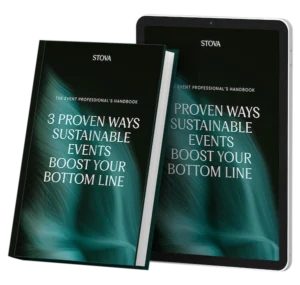How to Assess Your Event’s Carbon Footprint (Without Becoming a Carbon Accountant)
July 16, 2025

Record-breaking heatwaves in Southern Europe. Wildfires forcing evacuations in Canada and California. Floods and storms disrupting transportation, power grids, and daily life in every corner of the globe. Climate change is no longer a theoretical or future problem; it’s reshaping the environment (and events) in real time. For those in the business of convening people, particularly association and trade show organizers, this new reality demands more than acknowledgment. It demands action.
And yet, too often, sustainability efforts at events begin and end with a few recycling bins or a campaign against single-use plastics. While these initiatives are well-meaning, they often ignore the true heavy-hitters when it comes to carbon emissions.
So where should organizers begin? When every booth structure, attendee flight, and buffet item has a footprint, it’s easy to feel paralyzed.
You don’t need to become a climate scientist to get a handle on your event’s impact. This article will show you how to begin assessing your event’s carbon footprint and offer practical guidance to focus your efforts where they matter most.
How to Get Top-Down Support for Sustainability Initiatives
Before event managers can begin to allocate resources to sustainability tracking, they need to secure top-down support from their clients and other stakeholders. It’s critical to convey that, beyond its moral value, sustainability is becoming a strategic business priority.
While the Trump administration has taken an arguably counterproductive approach to the climate crisis, a recent study showed that 57.5% of event planners experiencing climate-related disruptions were in the US. To help combat this and other negative impacts, governments at the state level are taking matters into their own hands. Countries like the UK, France, Sweden, and the EU more broadly have also introduced legislation that codifies their 2050 net zero targets into law. As of 2024, many companies in the EU and the US are now required to report on their carbon emissions – and event organizers are taking note. According to the American Express Global Meetings and Events Forecast, 54% of respondents believe sustainability is either important or very important, and 47% have defined sustainability goals and an action plan.
This is in part because of strong financial incentives. Carbon credits and sustainability grants can all help offset the cost of greener event planning, but the real ROI comes from access to eco-conscious markets. Consumers are becoming more discerning. According to Booking.com’s 2024 Sustainable Travel Report, 75% of global travelers want to travel more sustainably, and 43% feel guilty when they make environmentally suboptimal choices. Companies are also critically assessing the environmental impact of business travel. Per the same Skift report, the U.S. Travel Association reported that 76% of executives “want to increase sustainable corporate travel choices – even if it costs more.”
If your event isn’t taking emissions seriously, you could soon find attendees turning elsewhere, and sponsors and exhibitors following suit. By openly tracking and reducing your event’s climate impact, you’re not just doing the right thing, you’re building trust, future-proofing your events and aligning with the values of the next generation of attendees and partners.
The Biggest Climate Culprits
To start reducing your event’s carbon footprint, you first need to understand where your emissions are coming from. According to the American Express Global Meetings and Events Forecast, 30% of event professionals cited environmental impact tracking as a major challenge.
The good news? You don’t need to assign a carbon value to every napkin. A “bucket-based” approach can help you zero in on the key areas that matter most:
Travel
According to multiple sources, attendee and exhibitor travel – especially air travel – is by far the largest contributor to most event-related emissions, often accounting for more than half of the total carbon footprint. This makes sense: according to the Myclimate flight carbon calculator, a passenger on a round trip from Toronto to New York emits around 0.366 t of CO₂ (compared to a person’s annual allotment of 0.6 t in order to stop climate change). This notably doesn’t seem to account for the kgCO₂e (kilograms of CO₂ equivalent), a metric that considers all the non-CO₂ chemicals produced that can multiply the negative impact by 2-4x.
Mitigate the Impact: Incentivize train travel for domestic attendees where possible, and consider regional rotations to reduce average travel distance if you have a dispersed attendee base. Offer carbon offset options in registration. For international events, consider hybrid formats that serve remote participants without the flight.
Venue Energy Use
Heating, cooling, lighting, and powering your venue all contribute to emissions. While the impact varies depending on the size of the space and the local energy mix, large convention centers can be substantial sources of indirect emissions.
Mitigate the Impact: Start with a destination that prioritizes sustainability as they are likely to have convention centers that reflect those values. Choose venues that use renewable energy or are certified green buildings. Relevant certifications include
- LEED: Leadership in Energy and Environmental Design, the most widely recognized rating
- ISO 20121: The International Organization for Standardization’s environmental rating specifically for the event industry
- EMAS: European Eco-management and Audit Scheme, another high standard for environmental management
Skift’s Rise of the Smart Venue report offers a solid overview of venue sustainability and a number of interesting case studies, including venues with interesting applications of solar power and green spaces.
Food and Beverage (F&B)
According to ReFED, an organization that focuses on food waste, surplus food accounts for 4% of U.S. greenhouse gas emissions and 16% of U.S. freshwater use. Catering choices have a significant footprint, especially when menus rely heavily on red meat and dairy.
Mitigate the Impact: Because meat-oriented agriculture is a major contributor to climate change, consider plant-forward menus that use local ingredients. Reduce over-ordering by using historical meal attendance data, and look for venues that divert surplus food from the garbage to the needy through established programs.
Waste Management
While not the biggest source of carbon emissions, waste is perhaps the most visible, and often the most mismanaged. Single-use materials, poorly sorted recycling and discarded promotional items all carry embedded costs to the tune of 2.5 lbs of waste per person per day, according to Skift.
Mitigate the Impact: Focus on reducing waste at the source by eliminating unnecessary items, encouraging digital materials/alternatives, like digital lead capture rather than business cards, and working with partners on reuse strategies. Where you have to print items like badges, consider eco-friendly badges that are biodegradable. If onsite badge recycling is not possible, Stova offers a recycling program as part of its climate commitment.
Production and Materials
Booth builds, staging, and signage add up. While individual components may seem small, they carry emissions through manufacturing, shipping and disposal.
Mitigate the Impact: Encourage modular and reusable booth designs that employ digital screens rather than printed materials. Discourage single-use props and infrastructure. Lastly, track materials usage year-over-year to reduce waste and help exhibitors optimize logistics.
Tools That Will Help You Track Your Climate Impact
Each event is different and there are a number of factors that contribute to the overall climate impact. Establishing that impact per attendee can be a forgiving but misleading way to look at the metrics, especially if your event is growing year over year but its carbon footprint is static (or growing, but not as fast as your audience). As Shawna McKinley of Clear Current Consulting advises, it is best to set a baseline, commit to reducing it over time and “measure progress against yourself.”
A good target to start with is a 50% reduction in emissions by 2030, in line with the Paris Agreement. You can formalize your commitment through initiatives like the SME Climate Commitment, which offers resources for smaller organizations to align with net zero goals.
Your own event data is an obvious first place to start. Look at previous events to gather data on meals ordered, attendance numbers, energy usage, and travel distance (from registration ZIP codes or countries). Most of these metrics can be provided through your event tech stack. For example, locations can be retrieved during the registration process, while badge check-ins for meal sessions will give you a picture of how many people you need to feed. This data gives you a baseline.
More carbon-specific tools and free online carbon calculators like the Myclimate Event Calculator can help you estimate emissions from travel, catering, accommodation and logistics.
The Institute for Sustainable Events (ISE) and Net Zero Tracker are also helpful resources that offer guides, tools and a side-by-side comparison of carbon calculators to help you select the right one for your event.
If tracking your carbon impact still seems daunting, hiring a sustainability consultant may be the solution, and is more affordable than you would think. These experts specialize in guiding event organizers through their first carbon assessments and action plans without overwhelming planning teams.
Event tech providers like Stova can also be important partners in your event sustainability action plans. Find out how to implement digital alternatives onsite, offer hybrid event support or reduce waste with smart badging.
Whether your event is virtual, hybrid, or in-person, enhance your attendee’s journey with an event ecosystem built for your audience. Ready to walk through Stova's event technology solutions? Schedule some time with us today.


